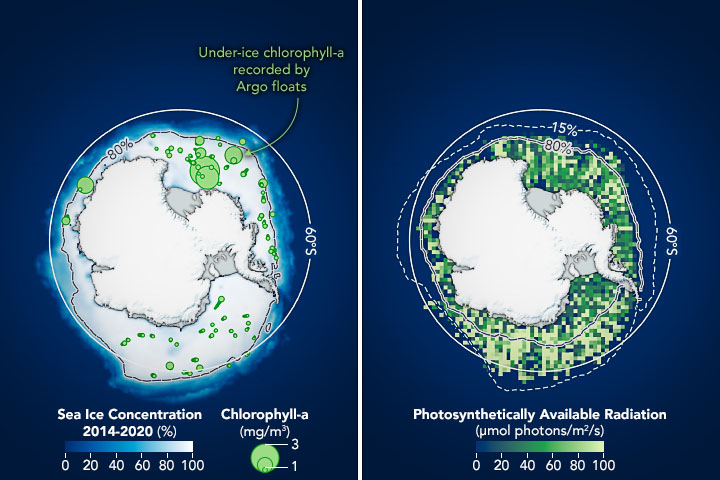The Arctic and Antarctic oceans are covered with ice all winter, and in some places all year round (at least until recent melting). These areas are little explored by land bound tropical primates, and have generally been assumed to be empty of light and life.
In recent years, observations have shown that the Arctic Ocean has considerable amounts of phytoplankton living under the ice, not just in ice free locations. This indicates that there is more light penetrating the ice than earlier assumptions. It is possible that this reflects effects of anthropocentric changes to the northern sea ice letting in more light, though there are indications that these plankton blooms were present decades ago.
But what about the southern sea ice around Antarctica? The ice in the south is more snow covered than in the north, and therefore higher albedo. On the other hand, it thins and breaks up in the spring, and, of course, anthropogenic changes are surely impacting the south.
This fall researchers from several institutions report substantial amounts of phytoplankton even before the spring ice retreated [2]. The study used data from ICESat-2 to map the ice and water samples taken by Argo floats. The water samples can indicate phytoplankton blooms, though the Argo floats do not measure close to the surface where the most phytoplankton would be. So these samples under estimate the presence of plankton.
The study also modelled the light and ice conditions in the area. The theoretical model suggests that there is enough light under the ice, which presumably could support widespread phytoplankton blooms.
These conclusions are plausible, though there are relatively few measurements in this inaccessible region. The researchers urge surface ship studies to look carefully for the signs of plankton blooms. They remark that earlier expeditions may have missed this difficult to detect phenomenon.
These results along with the related studies of the Arctic suggest that the polar sea ice may be home to considerably more biological activity than realized. This might impact global models of the oceans and Carbon.

- Michael Carlowicz, New evidence shows that a sufficient amount of daylight penetrates the ice to sustain blooms of floating, plant-like organisms, in NASA Earth Observatory – Image of the Day, November 29, 2022. https://earthobservatory.nasa.gov/images/150671/phytoplankton-may-be-abundant-under-antarctic-sea-ice
- Christopher Horvat, Kelsey Bisson, Sarah Seabrook, Antonia Cristi, and Lisa C. Matthes, Evidence of phytoplankton blooms under Antarctic sea ice. Frontiers in Marine Science, 9 2022. https://www.frontiersin.org/articles/10.3389/fmars.2022.942799
